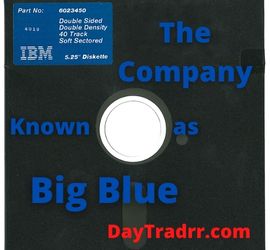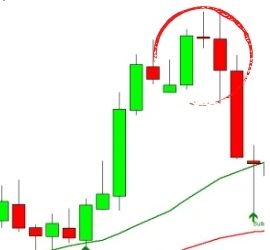What Is a Bear Trap Stock When Trading & Investing?
 A bear trap stock is a downward share price that lures investors to sell short but then sharply reverses with the price moving positively. In general, a bear trap is a technical trading pattern. It happens when the price movement of a stock, index, or other financial instruments wrongly suggests a trend reversal from an upward to a downward trend. Many analysts believe large institutional traders set bear traps. They sell assets until other traders are convinced that the rising trend has finished and prices will fall. As prices continue to fall, traders will be duped into assuming that the downward trend will continue and short the stock or security.
A bear trap stock is a downward share price that lures investors to sell short but then sharply reverses with the price moving positively. In general, a bear trap is a technical trading pattern. It happens when the price movement of a stock, index, or other financial instruments wrongly suggests a trend reversal from an upward to a downward trend. Many analysts believe large institutional traders set bear traps. They sell assets until other traders are convinced that the rising trend has finished and prices will fall. As prices continue to fall, traders will be duped into assuming that the downward trend will continue and short the stock or security.
The bear trap is then activated, the market recovers, and prices rise. It is this deceptive trading signal that causes the short sellers to lose money. If the institutional traders are successful, the price quickly rises again. This allows the institutional traders to dump greater amounts of stock, which would otherwise drive prices significantly lower.
The predicament facing short sellers when a bear market reverses its trend and becomes bullish. The assets continue to sell in anticipation of further declines in price, and short sellers then are forced to cover at higher prices. (Source: nasdaq.com)
Bear Trap Stocks – A Closer Look
In some markets, there may be a large number of buyers eager to acquire equities. However, only a small number of sellers are willing to accept their offers. In this instance, the purchasers may raise their bid—the amount of money they are ready to pay for the shares. This is likely to entice additional sellers to the market. As a result, the market will rise as a result of the imbalance in supply and demand. When stocks are bought, however, they instantly become a source of selling pressure since investors only profit when they sell. As a result, if too many individuals buy the stock, the purchasing pressure will diminish. However, the potential selling pressure will grow.
Institutional investors may deliberately drive prices lower in order to make the security appear to take a bearish turn. The strategy is to entice other traders to take the bait and sell the security short anticipating a continued downturn, However, when the stock falls in price, sideline investors rush back into the market. As a result, the stock price climbs in tandem with the increase in demand.
Stop-loss & pending sell orders
In other words, a bear trap is essentially a situation in which traders believe that a support level is about to break down. As soon as the price drops below the support level, they begin selling in response to the alleged downturn. Many traders are trained to trade breakouts by setting a pending sell order. This is triggered as soon as the price falls below a support level or a moving average. However, with a bear trap, the breakthrough turns out to be a ruse. The price rises above the support level again following the temporary bearish downturn. Traders often put their stops and limits very near the support level or the moving average.
In a normal market, this is expected to convert into resistance when crossed. However, there is no true breakout. There is only a temporary crossing of the support level or moving average before the price begins to rise again. Traders that short or sell as soon as the cross occurs find themselves on the wrong side. In the case of a bear trap, they find themselves on the short side.
Why Does A Bear Trap Happen?
Why Do Bear Traps Occur? Large industry participants sometimes find it in their interest to shake out the weak long or short positions. This might include large pension funds, big banks, or investment organizations. They do this so that they can acquire equities at wholesale pricing. As a result, the lower the entrance price, the better for their earnings. Typically, they play the long game with incredibly limited exposure. Of course, they often invest in stock markets, and stock markets are typically bullish. Therefore, to create demand for a specific stock, they push it to or below a set resistance level.
Bait and switch
Other traders see the stock retreat below the resistance level and sell short to continue the negative trend. But, the downturn is only temporary and sellers who enter too early get caught in the bullish reversal. Buyers that positioned their trade’s stop-loss objective too close to a support level or a moving average have their stop losses activated. As a result, major players have the opportunity they were looking for.
A bear trap can lead a market participant to assume there is a legitimate drop in the value of a financial instrument. In turn, this leads to executing a short position on the asset. With a bear trap, however, the asset’s underlying value remains steady and ultimately rises. This forces the short position to face a loss. A bullish trader may sell a dropping asset in order to lock in gains. A bearish trader seeks to short that item in order to purchase it back after the price has retreated to a particular level. If the downward trend does not materialize and returns positive within a short amount of time, the price reversal is classified as a bear trap.
Technical patterns are frequently used by market players to examine market movements and evaluate investment plans. Technical traders use a number of analytical techniques to avoid bear traps. For example, Fibonacci retracements, relative strength oscillators, and volume indicators. These techniques can assist traders in determining if a security’s current price trend is authentic and sustainable.
Bear Trap vs. Short Selling
A bear is a financial market investor or trader who feels that the price of a security is likely to fall. Bears may also assume that a financial market’s general trend is deteriorating. A bearish investing strategy seeks to profit from a drop in the price of an asset. As a result, a short position is frequently used to carry out this approach. A short position is a trading strategy in which a trader borrows shares or contracts of an asset from a broker using a margin account.
The investor sells the borrowed instruments in order to repurchase them when the price falls, so profiting from the loss. When a negative investor wrongly perceives a price downturn, the chance of falling into a bear trap increases. If the price rises instead of falling, short-sellers are forced to cover bets in order to limit their losses. A continued increase in purchasing activity may spark even more upside. The increasing momentum of the asset tends to lessen once short-sellers acquire the instruments necessary to cover their short bets.
A bear trap and short sale are not the same things. A bear trap involves short selling of a stock or other investment security. However, a decline in price triggers a bearish investor into a short sale. The investor does this to make money if the price continues to fall. However, it is the quick reversal and rapid price increase that causes the short seller to lose money.
Up Next: What Is Opening Range?
 The opening range is the high and low price for a given security during the first 30-60 minutes after the market opens. This range can be an indicator of market sentiment, trends, and price movements for the day’s trading session. Traders pay attention to a stock’s opening range since it might indicate market mood and price movements throughout the day. The belief is that what happens at the start of the day or trading session determines the market’s direction. The range in which a stock initially moves at first establishes resistance and support levels. Breaching these levels provides the trader with a signal to enter. It also defines the day’s lows allowing the stop loss level to be quickly established.
The opening range is the high and low price for a given security during the first 30-60 minutes after the market opens. This range can be an indicator of market sentiment, trends, and price movements for the day’s trading session. Traders pay attention to a stock’s opening range since it might indicate market mood and price movements throughout the day. The belief is that what happens at the start of the day or trading session determines the market’s direction. The range in which a stock initially moves at first establishes resistance and support levels. Breaching these levels provides the trader with a signal to enter. It also defines the day’s lows allowing the stop loss level to be quickly established.
European traders frequently monitor the first hour after the opening of the old continent stock exchanges. For example, between 8:00 and 9:00 A.M. CET after the opening in Frankfurt. Or, between 9:00 and 10:00 A.M. CET after the opening in London. US traders monitor the opening of the American stock exchanges and Asian traders monitor the opening of the Tokyo exchanges.




